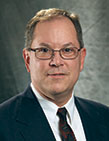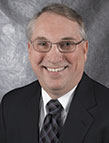Mobile Market Q&A
John Treharn, Vice President Business Development – Hydraulics Group, Parker Hannifin Corp.
John works with the company’s divisions to advance long-term growth strategies. He also helps define acquisition candidates and due diligence oversight when an acquisition is pursued. With 40 years of experience, he oversees development of business contracts with customers and development partners.
 Massimo Dovesi, Global Sales and Marketing Director, Turolla OpenCircuitGear (OCG)
Massimo Dovesi, Global Sales and Marketing Director, Turolla OpenCircuitGear (OCG)
Massimo has more than 15 years of experience in hydraulic engineering and sales/marketing. He has covered different roles during his career, designing and selling hydraulic components and systems. He has sales and marketing experience in the North American market and also in the APAC area, with a specific focus on India. He is currently based in Italy.
 Steve Zumbusch, Director of Application and Commercial Engineering (ACE), Eaton’s Hydraulic Group
Steve Zumbusch, Director of Application and Commercial Engineering (ACE), Eaton’s Hydraulic Group
After graduating from the University of Minnesota, Steve joined Eaton as a product development engineer, and over the last 30 years worked on different product lines and applications. His experience includes the role of engineering manager for the company’s power division, and he has received nine patents for a number of innovations.
In respect to the economy, in what areas do you see the mobile market picking up momentum or slowing down?
Treharn: Reflecting back, 2008 was a peak year for the mobile motion control market in North America. We saw a severe recession in 2009 and 2010, with a significant (but not total) recovery in 2011 and 2012. We anticipate no significant market momentum changes in either direction during 2013. Growth will result from adding incremental customer value and winning market share.
Dovesi: It is difficult to predict 2013 since it’s a year dominated by an economy that is trying to exit an important slowdown, and a number of OEMs are trying to reassure the market that we’ll see a growth. There is a lot of goodwill from the players, a lot of manufacturers ready to invest again, but we don’t have yet a sign that is safe to do so. As a result, I believe we will have a year that will be uncertain and mostly based upon the ups and downs in production. As a whole year, it could be flat, but there will be times where positive signs will come to the manufacturers that will transfer to component manufacturers.
Zumbusch: We are seeing a lot of folks maintain a cautious stance regarding the future. A number of manufacturers saw declines in orders, especially in construction equipment and followed by agriculture industries. However, we are seeing a number of customers continuing new equipment projects across the globe, particularly in Brazil and Asia Pacific, that are getting exciting.
Tegg: We definitely see an upturn in momentum in the woodlands industry. With new home and business start-ups, more land is being cleared. And with all of the strange weather and major storms of late, the chipper market has been brisk. On the other side, we have seen a reduction in some of our farm equipment OEMs. We believe this is mainly due to farmers switching from the crops that they typically grow to corn and beans as their prices continue to skyrocket.
How have the Tier IV emissions requirements made it easier and/or more difficult to conduct business?
Treharn: Tier IV emissions requirements have created a lot of opportunities—and challenges—in designing equipment and cooling systems with a bigger emphasis on efficiency.
Dovesi: Tier IV engines have been both a plus and a minus for us. Looking at them strictly from our perspective (therefore ignoring the obvious benefits related to emissions), they have introduced a need for more and better cooling systems. The minus of the Tier IV introduction is the critical mass of work that our customers need to do to introduce them, stealing time for machine redesign or improvement. It also has had an impact on the cost of the machine and ultimately on the ability of the manufacturer to capture “perceived” value from the customers; for example, the same machine from the past is now sold with just a different Tier IV engine (and a higher price), transferring to the market those extra costs without new features that could improve performance, comfort level, and ease of use.
Zumbusch: Hydraulic solution providers like Eaton have been anticipating the impact of Tier IV on costs and power availability for a while now. We recognize the balancing act OEMs have been facing in getting their engines selected and qualified versus time available to look at improving power management. With the dust settling on interim Tier IV and Tier IV Final, we believe that the need to manage available power will be more and more important. I think OEMs have started seeing the need to optimize their machines and deliver more to the end user for all the extra costs that came into play with Tier IV. This realization has allowed the message of higher-efficiency system solutions to start making its way into the discussions and next-generation system designs.
Tegg: We have found that we have less engine “real estate” to work with as far as mounting our products to the engine, which makes power to size/weight ratios more important than ever. The requirements have made it crucial for the OEMs to have hydraulic systems that use state-of-the-art variable platforms and high-tech controls that self-adjust to the new engine performance curves. One of the biggest benefits that we see coming from the Tier 4/3 engine platform is how easy it is to communicate with the engine through J1939. With our new CAN (controller area network) systems, we can tell exactly what is happening with the engine at all times and, within milliseconds, adjust the system to what best suits the requirement while optimizing the machine output and performance.
How has the increased focus on energy efficiency affected the mobile market’s role in fulfilling customer requirements and designing equipment?
Treharn: Our customers’ core emphasis is in designing and manufacturing equipment with higher levels of efficiency. As a result, I believe we will see more “high-end” engineered solutions to meet the requirements of the next generation of equipment.
Dovesi: As a component manufacturer, the request for more efficient machines is an opportunity to improve the technology. (I’m referring to a system that saves fuel consumption and improves controllability, like load-sensing technologies). As systems become more sophisticated, from the technical point of view, there needs to be more interaction between engineering departments and customers, and a need to resolve issues related to electronics communication or the system’s hydraulic responsiveness to the machine inputs. The past approach was more “single-component” related, but now I think that a higher technology level requires component manufacturers to better understand the entire system that controls the machine. Only by doing this can the manufacturers propose solutions for improvement.
Zumbusch: The increased focus on energy efficiency is causing mobile OEMs to take a new view on their equipment. As a result, they are recognizing that to manage the power most effectively, they need to be looking at the complete machine, not just individual components. Operating cost increases sparked by fuel prices and Tier IV engine packages have put everything hydraulic on the table for discussion—from parasitic loss analysis to more intelligent system controls. In the end, these machines still have to prove themselves—adding to the bottom line and delivering for end users.
Tegg: The energy focus has forced our OEMs in the agriculture, woodland, and material-handling industries to adapt to higher-efficiency products to optimize fuel-in vs. worked-performed ratios. With some of our customers’ larger platform machines, they can burn as much as 70 gallons of fuel per hour. Figuring fuel cost at $4.00 per gallon, it totals $2,240 in an eight-hour day, or $56,000 per month, or $672,000 per year. It is easy to see how quickly a 20% savings could add up. If we are able to control the engine to maximum efficiency at all times with our new controls system and design in load sensing and other high-efficiency products, the return on investment is realized very quickly, which will lead to more sales for all involved.
What areas of opportunity in the mobile market segment do you see as growth areas in 2013?
Treharn: I see a lot of growth in electronic controls—pumps, valves, actuators, etc.—and a continuation of using electronics to add intelligence to hydraulics.
Dovesi: In a market that is uncertain for volume and expansion, I think that as a manufacturer, we are a little bit in between the OEMs that drive the change and the market itself. More than market opportunities, I see specific opportunities at some OEMs to invest in new machines. Each market segment has leading customers and followers, and today we are seeing the gap between these two categories growing due to the investment level they can afford. If we want to look at the different segments, the potential growth is really related to what a certain component manufacturer has already done in that segment; looking at our company, specifically, we do have multiple opportunities in the lifting, construction equipment, and agricultural market due to the release of new products and the integration of improvements and accessories.
Zumbusch: Electro-hydraulics (or more accurately, mechatronics) in the mobile market has been growing for some time—and presents a number of advantages for OEMs. As the need to manage every bit of power produced by the machine continues to dominate design, we’re looking for more integration of power management. Controls that intelligently manage the combined engine power production and the hydraulic power conversion will be important for customers this year and in the future.
Tegg: We see a great opportunity in the CAN controls arena and the electro-hydraulic product that links it. We definitely see growth in any products that interface engine controls with hydraulic controls.
Are there any new products/innovations that you foresee as game changers in the industry?
Treharn: In general, I see continued innovation by adding electronic intelligence to hydraulic components, such as displacement control for piston pumps. Electronics coupled with hydraulic components and systems will be used to improve equipment safety, operator productivity, and optimized energy utilization for mobile equipment. Advanced series, hybrid transmissions are also starting to gain momentum, as they are now delivering significant fuel savings and emissions reductions on heavy vehicles with high stop/start duty cycles.
Dovesi: As a gear pumps/motor manufacturer, I don’t see an innovation we can define as an upcoming game changer, as this mature product has been through multiple improvements and redesigns over the years. There are pockets of technology improvement here and there, maybe more related to manufacturing processes rather than technology. Silent pumps will need to be more cost effective, and their usage could improve in different areas. There’s an opportunity to bring more value with a package that includes accessories that before were installed along the hydraulic line. I believe we should question ourselves more about the future of our segment, understanding how a mature product can change and still bring value. The competition from low-cost countries will drive many decisions and force us to diversify this added value to remain attractive and competitive. I do see many game-changer technologies out there for other components that could dramatically improve machine performance and ease of use, which is going to be a major factor in the coming years.
Zumbusch: Machine costs are king. Today and likely moving forward, we expect this issue to continue to be critical for end users. They need the machines to be reliable and reduce unexpected downtime to keep profits flowing. Products that can accurately predict replacement and maintenance needs are yielding value for customers as they seek to reduce operating costs. Sensing technologies like these will continue to be game changers going forward.
Tegg: Eaton’s new E-controls—This new open architecture is by far a game changer for our industry. They have developed a control platform that is very intuitive and does not lock the end OEM customer out. With process rates of three milliseconds, we are able to keep up with engine communication (J1939) and DTS’s design team builds the ability through onboard HMI troubleshooting screens to tell the user/OEM exactly what has failed from the engine to the pump to the directional coils or even the wiring. This lets the end customer know exactly what is happening with his machine and most of all, keeps downtime to a minimum.









